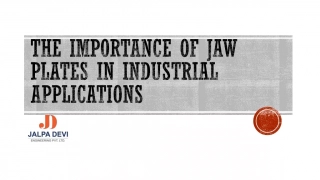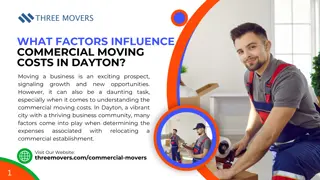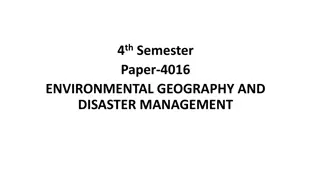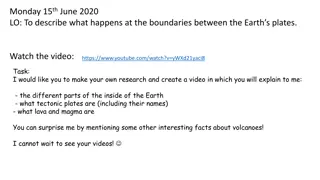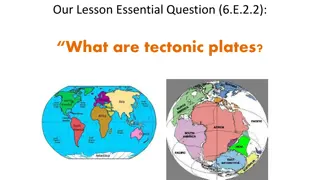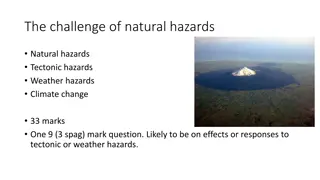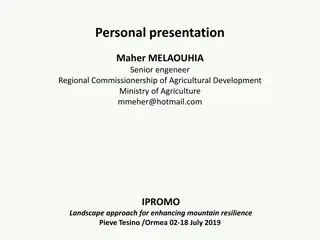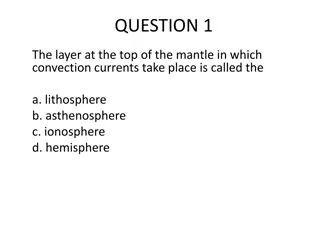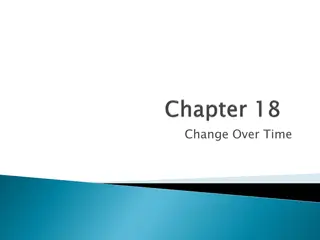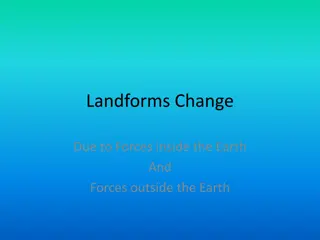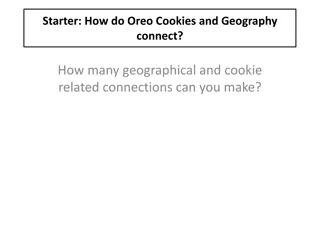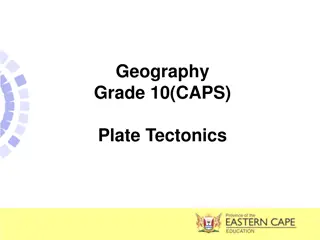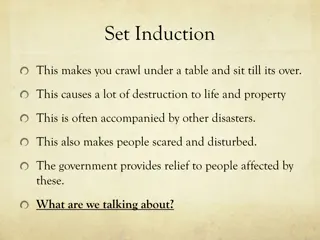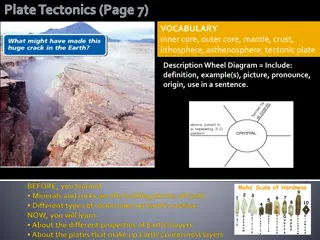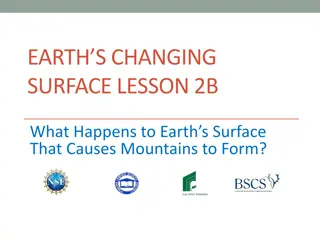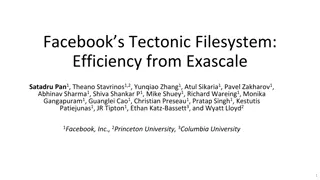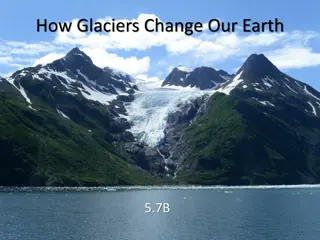Understanding Earth's Changing Surface: The Role of Moving Tectonic Plates in Mountain Formation
Earth's changing surface involves the movement of tectonic plates, which play a crucial role in building up the Earth's surface and forming mountains. Through investigations and models, we explore how these plates move and interact to shape our planet's features.
Download Presentation

Please find below an Image/Link to download the presentation.
The content on the website is provided AS IS for your information and personal use only. It may not be sold, licensed, or shared on other websites without obtaining consent from the author. Download presentation by click this link. If you encounter any issues during the download, it is possible that the publisher has removed the file from their server.
E N D
Presentation Transcript
EARTHS CHANGING SURFACE LESSON 3B Are the Moving Plates of Earth s Crust Involved in Building Up Earth s Surface and Forming Mountains? If So, How?
Review: Our Foam-Mat Model What did the foam mats represent? What did the arrows represent? What did we learn about how Earth s tectonic plates might move? What causes these plates to move? Photo courtesy of BSCS
Key Science Idea Earth s tectonic plates float on a thick layer of hot, slow-moving rock underneath. This layer of rock causes the plates to move.
Todays Focus Questions Are the moving plates of Earth s crust involved in building up Earth s surface and forming mountains? If so, how?
How Earths Plates Move: Our Ideas What ideas did our foam-mat investigation give us about how Earth s plates might move? How Earth s Plates Move
How Earths Plates Move: Scientists Ideas Scientists have discovered that Earth s tectonic plates move in 3 main ways. How the Plates Move Plates move toward each other and collide. Photo courtesy of BSCS Plates move away from each other. Photo courtesy of BSCS Plates move side to side (slide past each other). Photo courtesy of BSCS
Investigation: Plate Movements and Mountain Building Do you think any of these plate movements are involved in forming mountains? Look at your answer to the focus question from last time. Then talk with a partner about whether you think Earth s plates and their movements form mountains. Be ready to share your ideas with the class. Use your foam mats and arrows to show how you think plates move to form mountains.
Investigation: Plate Movement and Mountain Building Our conclusion:We think that when Earth s plates collide, mountain ranges build up.
Investigation: Plate Movement and Mountain Building Imagine that these graham crackers are two of Earth s crustal (tectonic) plates. What do you predict will happen when they collide? Photo courtesy of BSCS
Investigation: Plate Movement and Mountain Building Is this result what you predicted? Photo courtesy of BSCS Photo courtesy of BSCS How is this result similar to or different from the foam-mat collision?
Our Foam-Mat Model and Earths Plates Think about our foam-mat model and complete these sentences in your science notebooks: I think the foam mats are LIKEEarth s crustal plates because ______________. I think the foam mats are NOT LIKE Earth s crustal plates because ________.
Our Foam-Mat Model and Earths Plates Think about time as we compare our foam-mat model with Earth s crustal plates. How long did it take to push our foam mats together to create a plate collision? How long do you think it takes Earth s plates to move and collide to form mountains?
Our Foam-Mat Model and Earths Plates Earth s plates move only 1 to 16 centimeters a year. Imagine taking a whole year to move your foam mats just 1 centimeter! Can you demonstrate how slowly the mats would move?
Our Foam-Mat Model and Earths Plates Earth s plates move VERY, VERY slowly. That s why we can t see mountains being built. It happens a tiny bit at a time over many, many, many years. When Earth s plates DO move, what happen? What are some examples? (Hint: Think of events that happen in nature.)
Lets Summarize! What do you think now about how mountains form? Complete this sentence in your science notebook: I think mountains are formed by ________.
Our Focus Questions Are the moving plates of Earth s crust involved in building up Earth s surface and forming mountains? If so, how? Look at the answer to the focus questions that you wrote at the end of the last lesson. How have your ideas changed after today s investigation? Think about this for a moment and then share with a partner.
The Bubble Challenge! Draw this bubble map in your science notebook: Move Apart Move Side to Side Collide
The Bubble Challenge! What might you see or feel at each type of boundary between two of Earth s tectonic plates? Are the movements at these boundaries the same or different? What might happen at all of the boundaries? What might happen at only one type of boundary?
Key Science Ideas Let s review some key ideas about Earth s crustal plates and mountain building: Earth s surface is made up of tectonic (or crustal) plates that float on top of hot, slow- moving rock inside Earth. We think that mountain form where these plates collide. We also think that plate collisions sometimes cause volcanic eruptions and earthquakes.
Next Time In the next lesson, we ll see if we can find evidence to support the idea that mountains form when Earth s crustal plates collide. Stay tuned!


